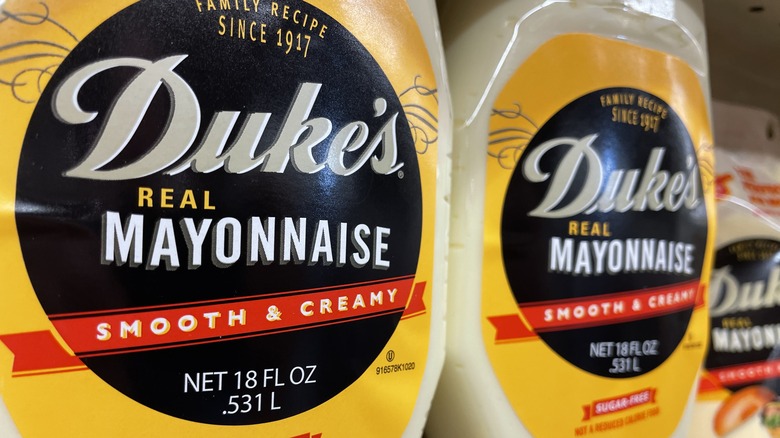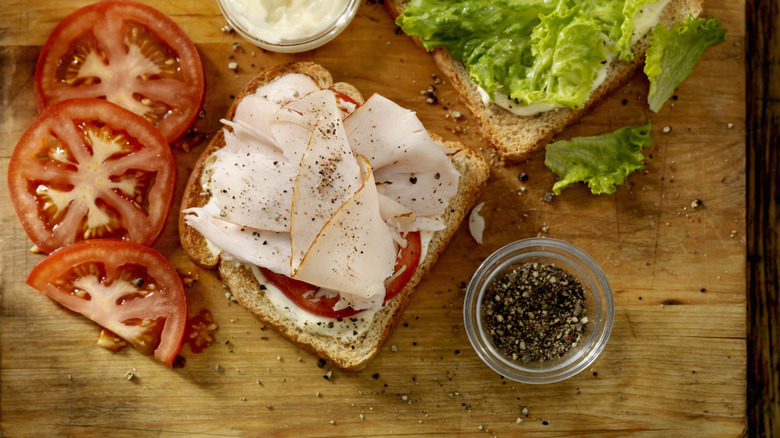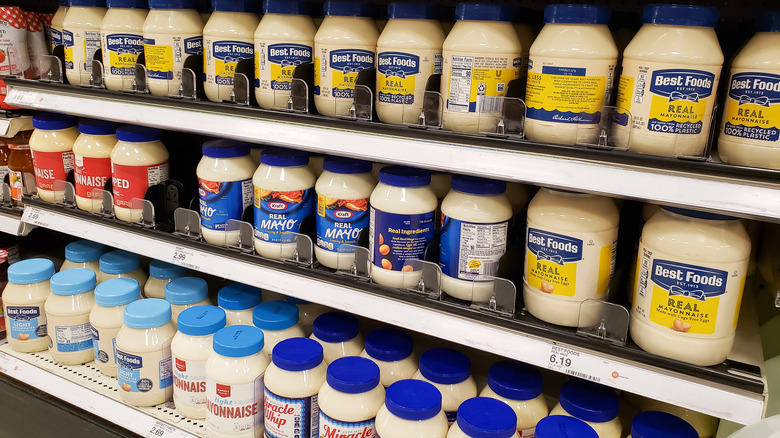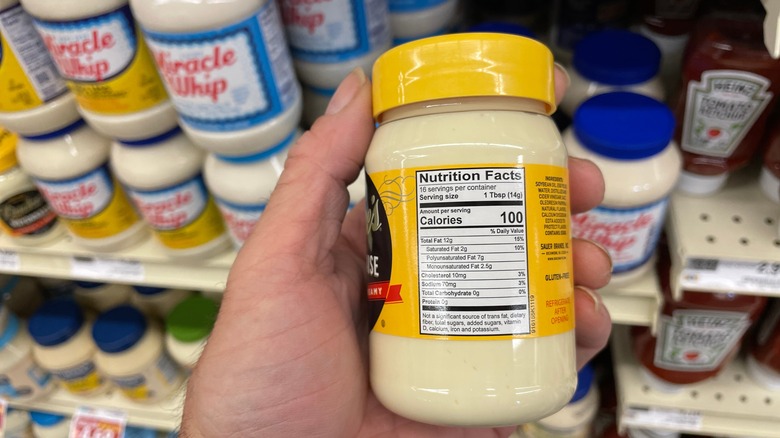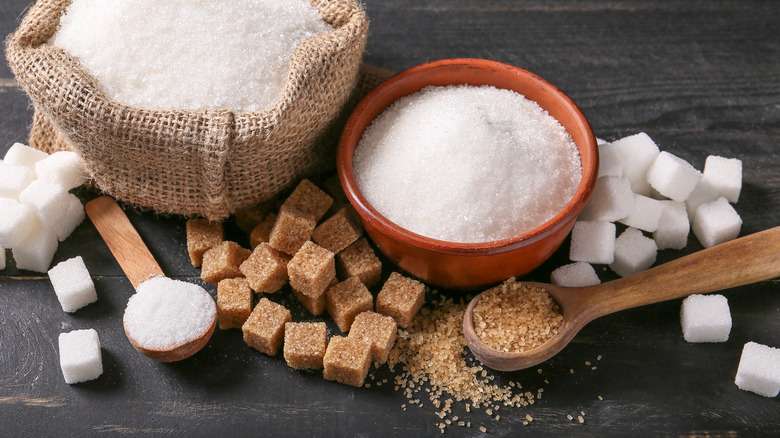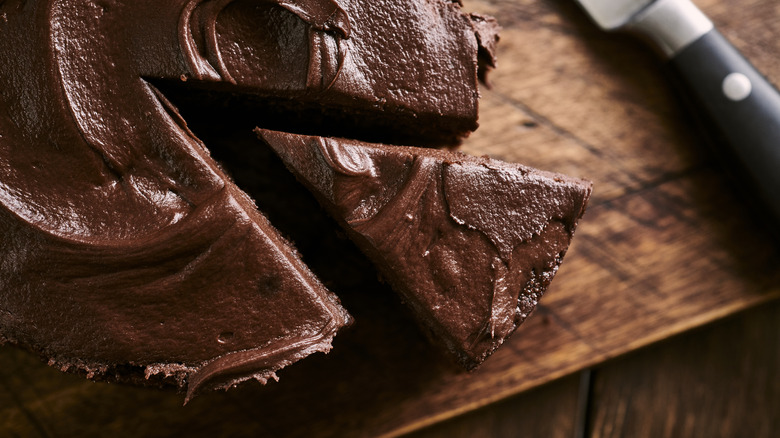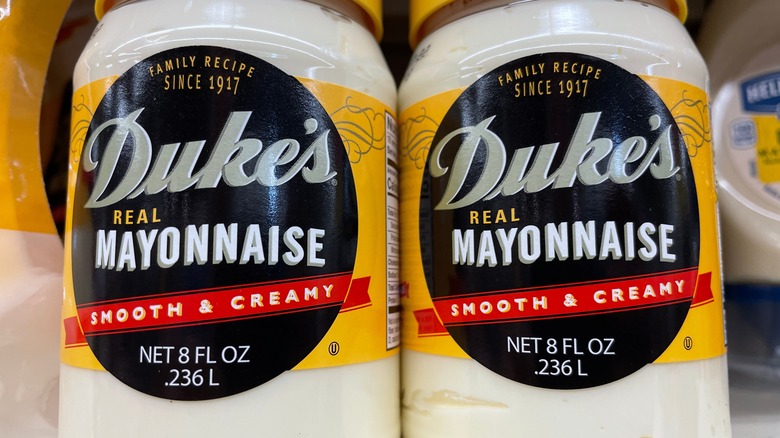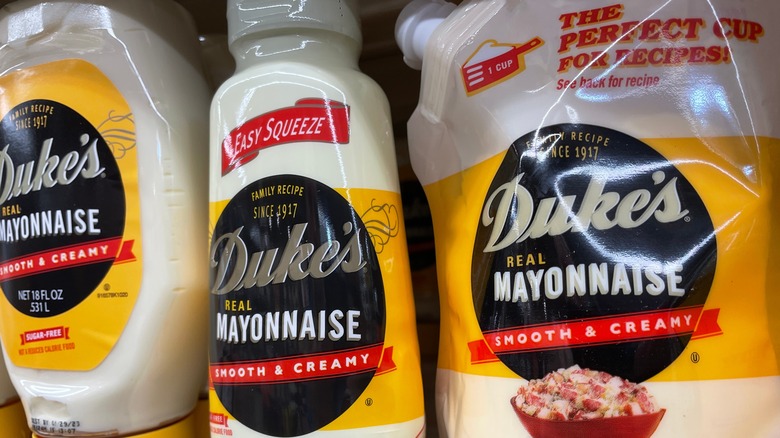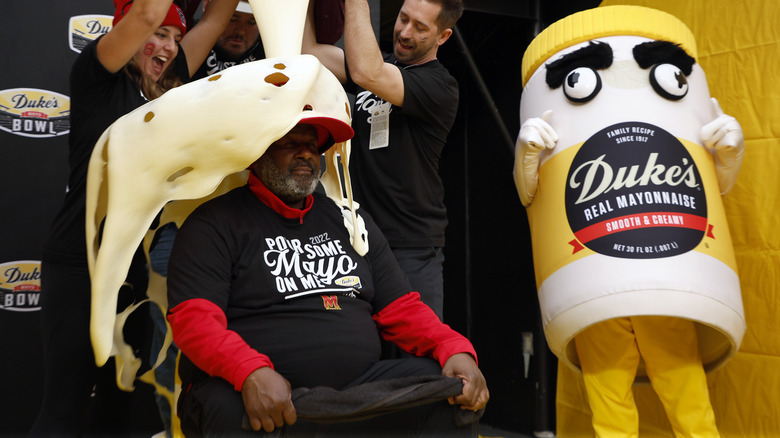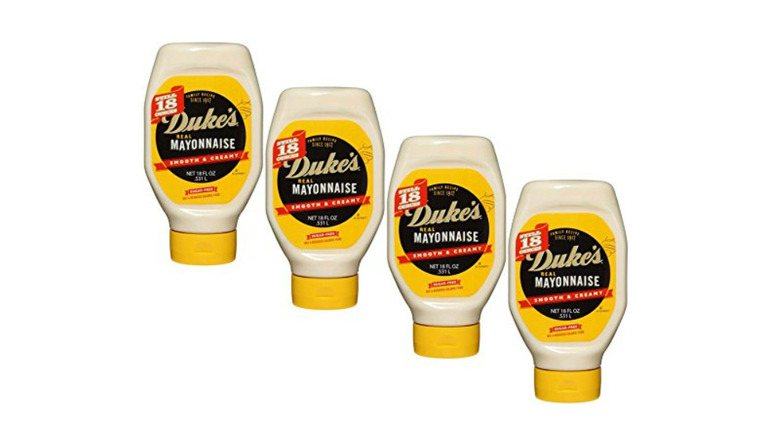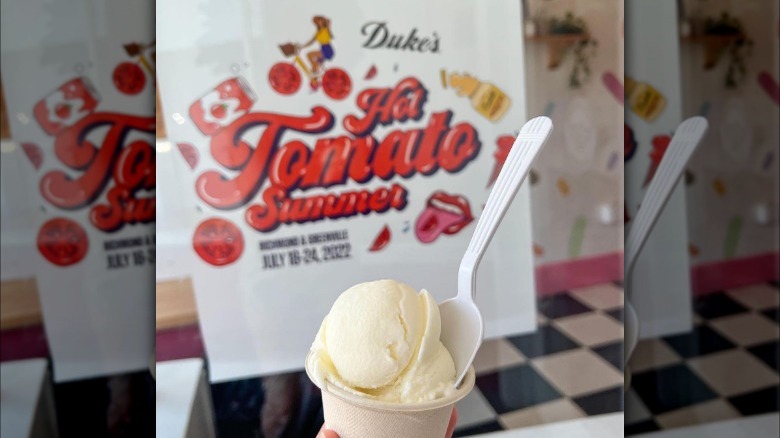12 Things You Need To Know About Duke's Mayo
We may receive a commission on purchases made from links.
If you're not from the American South, you may not be super-familiar with the Duke's brand. You may have glimpsed it on occasion on social media or heard about it online, or maybe you tuned in for the Duke's Mayo Bowl, if you're a college football fan. However, if you are from the American South, well, Duke's needs no intro.
Most Southerners could recognize a jar of Duke's from a mile away by the bold, cursive script on the egg yolk-yellow label. Most will have strong opinions about the condiment, with those voices who shout that Duke's is the superior mayonnaise on store shelves ringing the loudest. You'll find nary a southern spread for a picnic, barbecue, or holiday that doesn't include Duke's in some capacity, whether it's in the pimento cheese, cucumber salad, or chocolate cake (yes, chocolate cake — we'll get to that in a minute).
Whatever your current relationship with Duke's mayo, it's worth realizing that this condiment is so much more than just a simple spread. It's part of a regional culture, a brand founded by an ingenious woman, and just maybe the best thing you'll eat in the near future. Here's what you need to know.
1. The Duke's mayo brand started with sandwiches
If we go all the way back to the early aughts of the Duke's brand, we won't actually find the glass or plastic jars of mayonnaise with the cheery yellow label on the front that you might know. Instead, the Duke's brand got its start with sandwiches, not mayonnaise, in 1917.
Eugenia Slade Duke was a housewife living in South Carolina when World War I began. Soldiers, before going on their way to the war front, were stationed near her home and she saw a business opportunity there. She enlisted her daughter's assistance and began making sandwiches to sell. Of course, as you could probably expect these sandwiches were pretty heavily mayo-based. Sandwiches were just a dime apiece (which resulted in a 2-cent profit for every purchase) and Eugenia sold egg salad and chicken salad sandwiches, alongside, of course, the southern staple pimento cheese. The mayo, though, was the star.
Still, Eugenia kept up with the sandwich business for years. After the war, she sold sandwiches to drugstores and began amassing an employee base to help her fill her many, many sandwich orders.
2. Duke's switched to mayo in 1923
Finally, in 1923, Duke was convinced: Her amazing mayonnaise was the thing that really set her sandwiches apart (it probably helped that she received letters from her very first customers, the soldiers, asking for more mayo). Realizing that it would be far more business-savvy to make the big switch from perishable sandwiches to jarred mayo, she opened a factory later that year.
However, while the Duke's brand continued to see quick success, and she was eventually able to sell the mayonnaise brand, she didn't stay away from the sandwich business forever. After her retirement in sunny California, she channeled her entrepreneurial spirit to found The Duchess Sandwich Company.
Today, the Duke's brand is owned by a private equity firm, and the Duke's parent company is C.F. Sauer Co. — the original and same company that bought Duke's from Eugenia in the 1920s and that also produces a range of other food products, including additional condiments and spices.
3. Duke's boasts a cult following in the South
Ask any Southerner about mayonnaise and you'll likely inevitably hear about Duke's, but just how deep does the Duke's cult following run? Well, according to one report in the Washington Post, pretty amazingly deep. A reporter for the publication found that Southerners will do all sorts of ... interesting ... things for their love of the mayonnaise. The Duke's corporate office receives all sorts of fan mail, including, supposedly, quite a large number of paintings of the iconic, yet simple, Duke's jar design. Some fans will use the jars for their wedding reception centerpieces; others request Duke's mayo while on their deathbeds.
On Reddit, some Duke's fans tried to explain to one curious Brit just what makes Duke's so special. Most agree that the ingredients are just superior, resulting in a taste that's not quite homemade, but pretty darn close. As one fan summed up, "A BLT w/ Duke's mayo never fails to make me feel a little bit better about life."
4. Duke's is the third most popular mayo on the market
While Duke's does have a fantastic following in the South, though, it's not as popular in every single region around the United States. Overall, Duke's is the third most popular mayonnaise on the market, falling behind Hellmann's and Kraft.
What's the difference between the three (and the other mayos on the market)? Southern Living sought to find out in a taste test. The publication proclaimed that Duke's offers the most balance, in terms of flavors, making it ideal for use in recipes. Hellmann's Mayonnaise, meanwhile, is tangy, though not as tangy as Miracle Whip. Kraft Real Mayo, though, kicks the flavor up a notch through the addition of ingredients like onion and garlic.
None of these three mayos do it for you? If you really want to, you can dive down further into lesser-known mayos on the market, like Blue Plate Mayonnaise, a Louisiana specialty that is sweet, or Bama Mayonnaise, an Alabama and Mississippi favorite with a lemon-y tang.
5. Duke's is made with an extra-unique recipe
For many Duke's fans, the brand's superiority all comes down to the recipe. Duke's includes a few ingredients in its mayonnaise that really help it to stand apart.
For example, there are more egg yolks than the average store-bought mayo. This adds extra flavor and boosts the texture. Vinegar adds a little tang, but not quite as much as what you might get with Hellmann's or Miracle Whip. Paprika is added for some subtle, spicy zest that gives the mayo a little more depth in flavor. Duke's mayonnaise is rich and has a thick and creamy texture more akin to a thick pudding. The overall result is a mayo with a texture and flavor that just looks, feels, and tastes like homemade mayonnaise. For those who love homemade mayonnaise, but hate making it, this is great news.
While you can certainly make your own mayonnaise at home, with a jar of Duke's, you'll get that homemade taste without the hassle.
6. Duke's is sugar-free
For all of the good stuff that Duke's adds into its mayonnaise in order to achieve the taste and texture that fans love, it also leaves something very important out, which just adds to its appeal: sugar. Yep, Duke's mayonnaise is sugar-free and has been since Eugenia Slade Duke whipped up her first batch. While she forwent the sugar due to wartime rationing, it was a decision that proved popular with her customers and so the sugar-free mayo stayed.
This fact is made even more special when you consider just how much sugar lurks behind the seemingly innocent facades of the other condiments within your fridge. Barbecue sauces, for example, are notoriously high in sugar, with some even listing the very first ingredients as high-fructose corn syrup. Ketchup is also often high in sugar. In other words, if you have your choice of multiple condiments, Duke's is on the table, and you're watching your sugar intake, go with Duke's.
7. One of the favorite Duke's recipes is for a mayo chocolate cake
There are loads of favorite ways to use Duke's — on a summertime tomato sandwich or BLT, in pimento cheese, and even in scrambled eggs — but one of the more unique (and top favorite) ways to use Duke's is in your chocolate cake. Yes, mayonnaise in a chocolate cake.
Think about it. What is mayonnaise made of? Eggs. Oil. What do most cakes have as their primary wet ingredients? Eggs. Oil.
So, while the flavor can't really be detected once the cake is baked, the mayonnaise acts as a texture booster thanks to its creaminess. More specifically, the lecithin in mayonnaise adheres the oil in your batter to the flour in your batter, making the entire cake more moist.
The first recipe for a cake that included store-bought mayonnaise can be traced to the 1920s — right around the time that Eugenia Slade Duke founded Duke's. At the time, the mayonnaise wasn't used in cakes for texture enhancement, but just because fats and eggs were in short supply due to the wartime effort.
8. Someone out there is using a Duke's jar as an urn
Once we reach a certain age, most of us begin to think about where we would like to spend our eternities. Would we prefer a spot in the family burial plot? To be spread across a favorite spot in nature? To rest in a beautiful urn that our children can easily take with them, wherever they go? For one Duke's fan, the answer was easy: in a Duke's jar.
A woman once wrote to the brand requesting some Duke's glass jars (the glass jars are a little difficult to find now since the brand primarily uses plastic jars), which she would then set aside for her cremated remains. She needed three jars, specifically, one for each of her children. Duke's obliged and provided the requested jars.
But there wasn't just one request like this. Yet another individual wrote to Duke's requesting glass jars for his remains, too. Duke's, once again, honored this request, and even threw in some custom Duke's labels, printed with the man's name.
9. You can buy Duke's in a single-cup squeeze pouch
You know about peanut butter that comes in a squeeze pouch for easy, on-the-go snacking, and even sour cream that comes in a squeeze pouch for when you only need a little bit and not the entire tub. But mayonnaise in a squeeze pouch?
Yes, Duke's introduced the Duke's 1 Cup Pouch in 2015, a decision that the brand referenced as the most innovative thing to happen to mayonnaise since brands swapped their glass jars for plastic. As the name suggests, each pouch contains just 1 cup, or 8 ounces, of mayonnaise, ideal for many recipes.
The single-use pouches also come with a different and maybe unexpected benefit. Whenever you need one, just pull it out of the pantry and there's no need to worry about storing a large jar of mayo in your fridge. Of course, if you are storing a large jar of mayo in your fridge, you may be doing so unnecessarily, as some studies have now found that commercially produced mayos require no refrigeration, thanks to their acidity (via TODAY).
10. The Duke's Mayo Bowl offers plenty of college football fun
There are a fair number of college bowl games out there that boast food brand sponsorships, but Duke's is a relative newcomer on the scene, with the Duke's Mayo Bowl and Duke's Mayo Classic just announced in 2020. New or not, watch one of these games and you'll likely wonder why it took so long to get a mayo-themed football game in the first place.
For starters, Duke's mans the football field with its new mayonnaise mascot, christened Tubby, who is a large jar of mayonnaise with yellow legs, arms, and some big, bushy eyebrows. Tubby's name was chosen by social media followers, where the character has received a fair amount of love. Then, beyond the amazing mayo mascot, the Duke's Mayo Bowl also spreads the love to the winning team via the mayonnaise dump, which is just what it sounds like. Rather than dumping a vat of Gatorade on the winning coach's head, at the Mayo Bowl, coaches are treated to a shower of a big cooler of mayonnaise.
11. Duke's been involved in a few legal battles
When Eugenia Slade Duke sold off her company, she didn't sell off all of her efforts to one buyer. Instead, Duke's Mayonnaise, inclusive of the mayo recipe and the Duke brand, went to C.F. Sauer Company, while the earlier sandwich business went to Duke Foods. This has, as you might expect, caused some problems.
In one instance, the two companies "duked" it out, after Duke Foods began producing a line of sandwich spreads. Somewhat understandably, Duke's Mayonnaise sued Duke Foods for what it felt was misleading to the tried-and-true Duke's fanbase.
In another instance, a Duke Foods corporate employee supposedly got their hands on Duke's Mayonnaise's secret mayonnaise recipe and intended to take it to his new job at Knott's Foods (though some reports clarify that the individual in question didn't manage to steal the mayo recipe, just recipes for other spreads related to Eugenia Slade Duke's legacy). Much like Duke's, Knott's produces a line of fan-favorite, southern-inspired products, including ready-made pimento cheese, chicken salad, and dips — all things where you might want to include some really amazing mayo.
12. Duke's is no longer just mayonnaise
In more recent years, from 2020 on, Duke's has expanded its expertise beyond the world of plain mayonnaise, bringing fans a range of other condiments, as well as new takes on mayonnaise. In 2020, Duke's introduced its Southern Sauces, a selection of southern-inspired barbecue sauces reflecting barbecue traditions around the South, with different flavors for different states. In 2021, the brand released flavored mayonnaise like a Habanero Garlic variant and a Hint of Lime flavor. In 2022, Duke's went after the mustard industry, with flavored mustards like Brown Sugar Bourbon and Smoky Chipotle mustards. Most recently, in 2023, the brand started offering seafood sauces, with tartar sauce, remoulade, and other options that reflect the South's seafood favorites.
Duke's has branched its brand out in other ways, too, in recent history. In 2022, it operated some Duke's-inspired ghost kitchens in Raleigh, North Carolina. It's also partnered with multiple cities in the South to organize Hot Tomato Summer events for subsequent years — restaurant week-like events that put the focus on the classic tomato-and-mayo combo at restaurants throughout a destination.
So, while Duke's may be best known for its mayonnaise, the thing it arguably does best, that doesn't change the fact that more than a century after Eugenia Slade Duke sold her first sandwich, Duke's is far more than just mayo.
